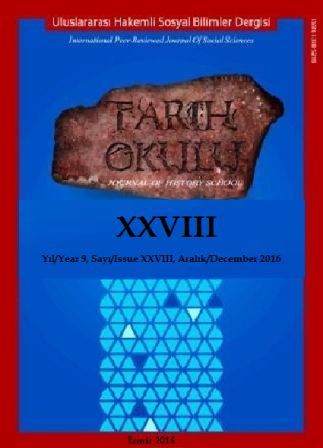Author :
DOI : 10.14225/Joh1017
Year-Number: 2016-XXVIII
Language : null
Konu : Eski Mezopotamya Tarihi
Abstract
Keywords
Abstract
Keywords
- Assyrian-English-Assyrian Dictionary (2007). Assyrian-English- Assyrian Dictionary. Ed. S.Parpola, The Neo-Assyrian Corpus Project, 289 pp., Helsinki.
- Barjamovic, G. (2011). Pride, Pomp and Circumstance: Palace, Court and Household in Assyria 879-612 BCE. Royal Courts in Dynastic States and Empires, A Global Perspective, (Eds.) J.Duindam-T.Artan-M.Kunt, Koninklijke Brill NV, Leiden, 27-62.
- CDA (2000). A Concise Dictionary of Akkadian, (Eds) J.Black- A.George-N.Postgate, 2 nd Edition, Harrassowitz Verlag, 450 pp.,Wiesbaden .
- Dezsö, T. (2012). The Assyrian Army. 1.Infantry, Eötvös University Press, 334 pp., Budapest.
- Duymuş Florioti, H.H. (2015). Çivi Yazılı Metinler ve Arkeolojik Kaynaklar Işığında Asur Imparatorluk Dönemi Kraliçeleri/Assyrian Queens of the Imperial Period in the Light of the Cuneiform Texts and the Archaeological Sources, Arkeoloji ve Sanat Yay.,85 s., Istanbul.
- Duymuş Florioti, H.H. (2014). Asur Imparatorluk Dönemi Kaynaklarında Geçen Müzisyen Kadınlar Hakkında Kısa Bir Not. Uluslararası Hakemli Tarih Okulu Dergisi 7/XVIII (Haziran), İzmir, 99-119.
- Duymuş Florioti, H.H. (2012). Yeni Asur Metinlerinde Geçen “Masennu” Unvanlı Bazı Memurlar. Ankara Üniversitesi Tarih Araştırmaları Dergisi 31/52 (Eylül), Ankara, 1-22. Galil, G. (2007). The Lower Stratum Families in the Neo-Assyrian Period, Brill, Leiden, Boston.
- Henshaw, R.A. (1967). The Office of Šaknu in Neo-Assyrian Times I. JAOS, Vol.87, No.4 (Oct.-Dec.), 517-525. Henshaw, R.A. (1968). The Office of Šaknu in Neo-Assyrian Times II, JAOS, Vol.88, No.3 (Jul.-Sep.), 461-483. Kertai, D. (2014). From bābānu to bētānu, Looking for Spaces in Late Assyrian Palaces. The Fabric of Cities, Aspects of Urbanism, Urban Topography and Society in Mesopotamia, Greece and Rome, Edited by N.N.May and U.Steinert, Brill, Leiden, Boston, 189-202. Köroğlu, K. (2006). Eski Mezopotamya Tarihi: Başlangıcından Perslere Kadar. İletişim Yayınları, 229 s., İstanbul.
- Macgregor, S.L. (2012). Beyond Hearth and Home, Women in the Public Sphere in the Neo-Assyrian Society. State Archives of Assyria Studies, Vol.XXI, 154 pp.,Helsinki.
- Melville, S.C. (2004). Neo-Assyrian Royal Women and Male Identity: Status as a Social Tool. Journal of the American Oriental Society, Vol.24, No.1, 2004, 37-57.
- Melville, S.C. (1999). The Role of Naqia/Zakutu in Sargonid Politics. State Archives of Assyria Studies Vol.IX, The Neo-Assyrian Text Corpus Project, 125 pp.,Helsinki.
- Parpola, S. (2012). The Neo-Assyrian Royal Harem. Leggo!Studies Presented to Frederick Mario Fales on the Occasion of His 65 th Birthday, (Eds.) G.B.LanfranchiD.M.Bonacossi-C.Pappi-S.Ponchia, Leipziger Altorientalistische Studien, Band 2, Harrassowitz Verlag, Wiasbaden, 613626.
- Richter, S. L.(2002). The Deuteronomistic History and the Name Theology, Iešakkēn šemô šām in the Bible and the Ancient Near East, Walter de Gruyter, 246 pp., Berlin-New York.
- SAA 06: T.Kwasman & S.Parpola (1991). Legal Transactions of the Royal Court of Nineveh. Part I: Tiglath-Pileser III through Esarhaddon, State Archives of Assyria, Volume VI, 370 pp., Helsinki.
- SAA 13: S. W. Cole&P. Machinist (1998). Letters from Assyrian and Babylonian Priests to Kings Esarhaddon and Assurbanipa., State Archives of Assyria, Volume XIII, 221 pp., Helsinki.
- SAA 14: R. Mattila (2002). Legal Transactions of the Royal Court of Nineveh. Part II: Ashurbanipal Through Sin-šarru-iškun, State Archives of Assyria, Volume XIV, 382 pp., Helsinki.
- SAA 16: M. Luukko& G. Van Buylaere (2002). The Political Correspondence of Esarhaddon. State Archives of Assyria, Volume XVI, 221
- Sever, H. (1987). Asur Siyasi Tarihinin Ana Devreleri. DTCF Dergisi, Cumhuriyet’in 60.Yıldönümü Armağanı, Ankara, 421-428.
- Sevin, V. (2009). Asur. National Geographic Türkiye, No.93, Doğuş Grubu İletişim Yayıncılık. 160 s., İstanbul.
- Stol, M. (1995). Women in Mesopotamia. JESHO Vol.38, No.2, Brill, 123-144.
- Svärd, S. (2012a). Women, Power and Heterarchy in the Neo-Assyrian Palaces. Organization, Representation, and Symbols of Power in the Ancient Near East: Proceedings of the 54th Rencontre Assyriologique Internationale at Würzburg, 20–25 July 2008, Ed. Gernot Wilhelm, Winona Lake, IN, 507-518.
- Svärd, S. (2012b). Power and Women in the Neo-Assyrian Palace, Helsinki University Print, 290 pp., Helsinki. Teppo, S. (2005). Women and Their Agency in the Neo-Assyrian Empire. Unpublished MA Thesis, University of Helsinki, 139 pp., Helsinki. Teppo, S. (2007). The Role and the Duties of the Neo-Assyrian Šakintu in the Light of Archival Evidence. State Archives of Assyria Bulletin Vol.XVI, 257-272. Winter, I. J. (1993). Seat of Kingship/ A Wonder to Behold : The Palace as Construct in the Ancient Near East. Palaces of the Ancient Near East and the Late-Antique Mediterranean World, Part I, (ed.) Gülru Necipoğlu, Ars Orientalis Vol. 23, 27-55.
